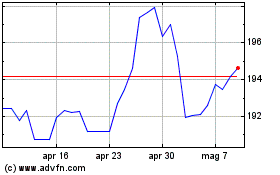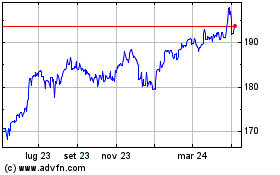Pound Slides After U.K. GDP Data
28 Settembre 2018 - 8:50AM
RTTF2
The pound slipped against its most major counterparts in the
European session on Friday after a data showed the U.K. economy
grew by 0.5 percent in the first half of this year, marking the
weakest half-year growth since 2011.
Data from the Office for National Statistics showed that gross
domestic product grew 0.4 percent in the second quarter, unrevised
from the previous estimate. The growth rate for the first quarter
was revised down to 0.1 percent from 0.2 percent.
On a yearly basis, the economy expanded 1.2 percent, which was
revised down slightly from 1.3 percent.
Due to higher visible trade deficit and primary income
shortfall, the current account deficit widened by GBP 4.6 billion
to GBP 20.3 billion in the second quarter. This was equivalent to
3.9 percent of GDP.
Further undermining the currency was falling European shares, as
Italy's new government offered a budget with a deficit target three
times as big as the previous administration's goal, putting the
country at odds with the European Union.
The currency was trading mixed against its major opponents in
the Asian session. While it held steady against the euro and the
franc, it rose against the greenback and the yen.
The pound slipped to 1.3034 against the greenback, its lowest
since September 13, and marked a 0.4 percent decline from a high of
1.3090 hit at 2:00 am ET. The pound is poised to find support
around the 1.27 region.
After rising to 148.64 against the Japanese currency at 1:00 am
ET, the pound reversed direction and weakened to 147.84. The pound
is seen finding support around the 145.00 level.
Data from the Ministry of Land, Infrastructure, Transport and
Tourism showed that Japan's housing starts increased for the first
time in three months in August.
Housing starts advanced 1.6 percent in August from last year,
reversing a 0.7 percent drop in July. Orders were forecast to climb
0.4 percent.
The pound reached as low as 1.2732 against the franc, a 0.4
percent slide from a high of 1.2783 seen at 5:45 pm ET. On the
downside, 1.25 is seen as the next likely support for the
pound.
Data from the KOF Swiss Economic Institute showed that an
indicator measuring the trends in the Swiss economy rose in
September, suggesting that the downward trend in the economy may
have come to a halt.
The KOF Economic Barometer climbed by 3.3 points to a new
reading of 102.2. Economists had forecast a score of 100.
On the flip side, the pound strengthened to a weekly high of
0.8880 against the euro, after having risen to 0.8912 at 4:30 am
ET. The next possible resistance for the pound is seen around the
0.87 region.
Flash data from Eurostat showed that Eurozone inflation
accelerated in September on food and energy prices.
Inflation rose marginally to 2.1 percent, in line with
expectations, from 2 percent a month ago.
Looking ahead, Canada industrial product price index for August
and GDP data for July, as well as U.S. personal income and spending
data for August and University of Michigan's final consumer
sentiment index for September are set for release in the New York
session.
At 9:20 am ET, the Bank of England Deputy Governor David Ramsden
speaks at the Society of Professional Economists Annual Conference,
in London.
Grafico Cross Sterling vs Yen (FX:GBPJPY)
Da Mar 2024 a Apr 2024

Grafico Cross Sterling vs Yen (FX:GBPJPY)
Da Apr 2023 a Apr 2024
